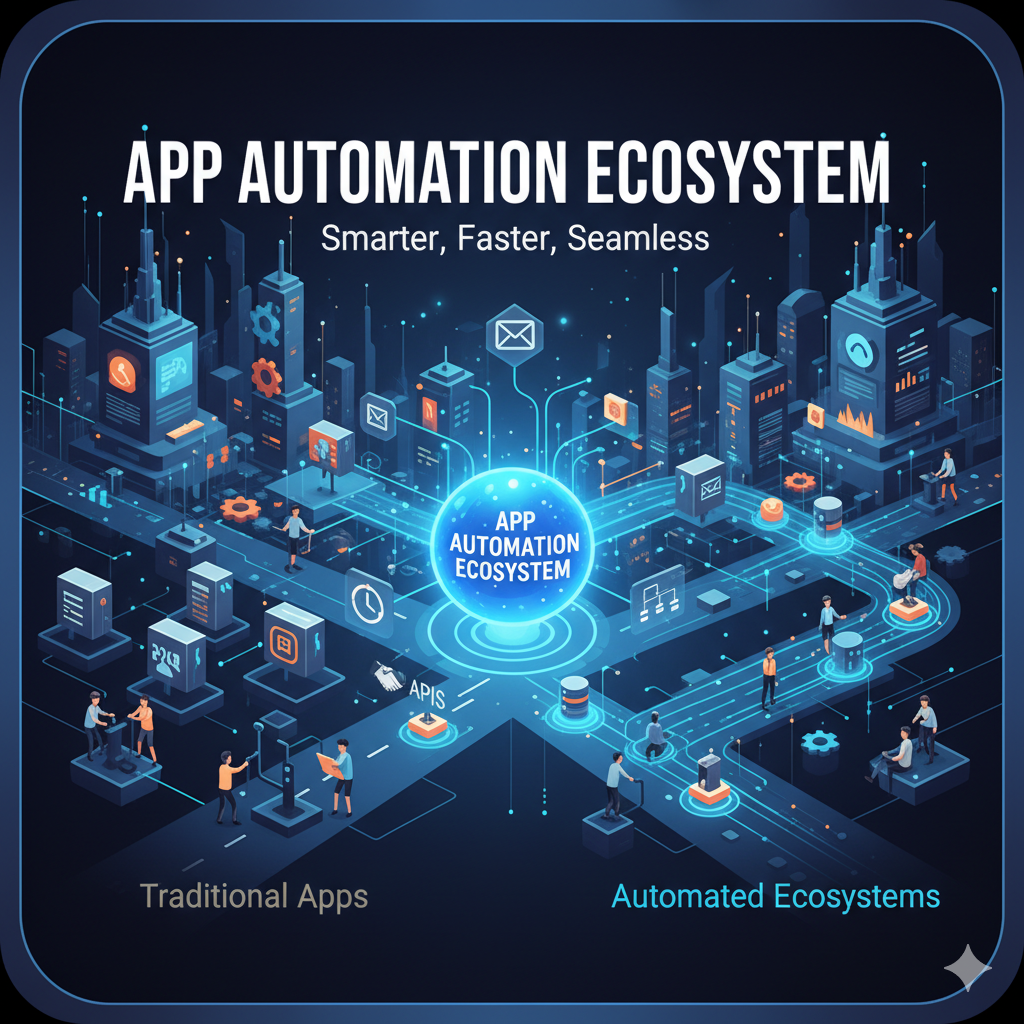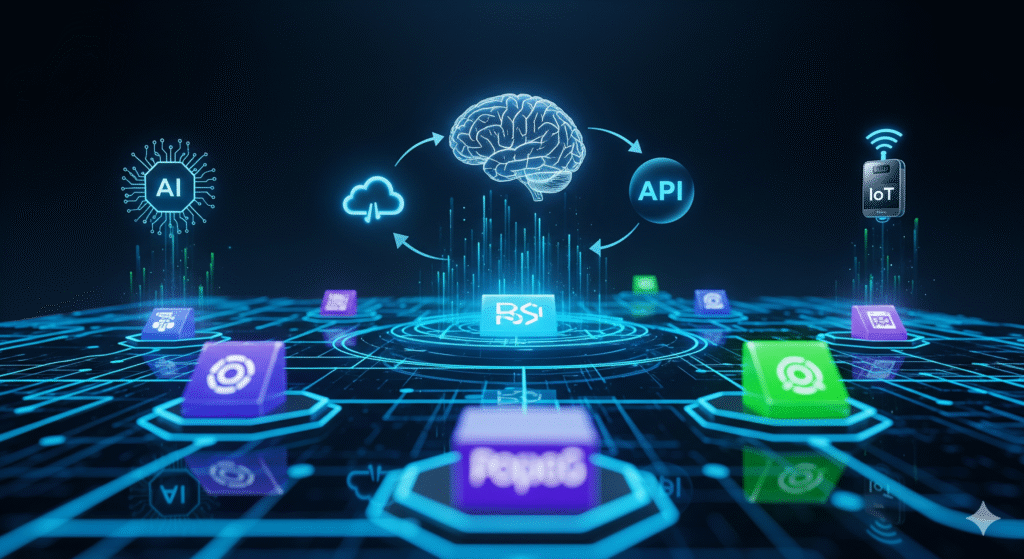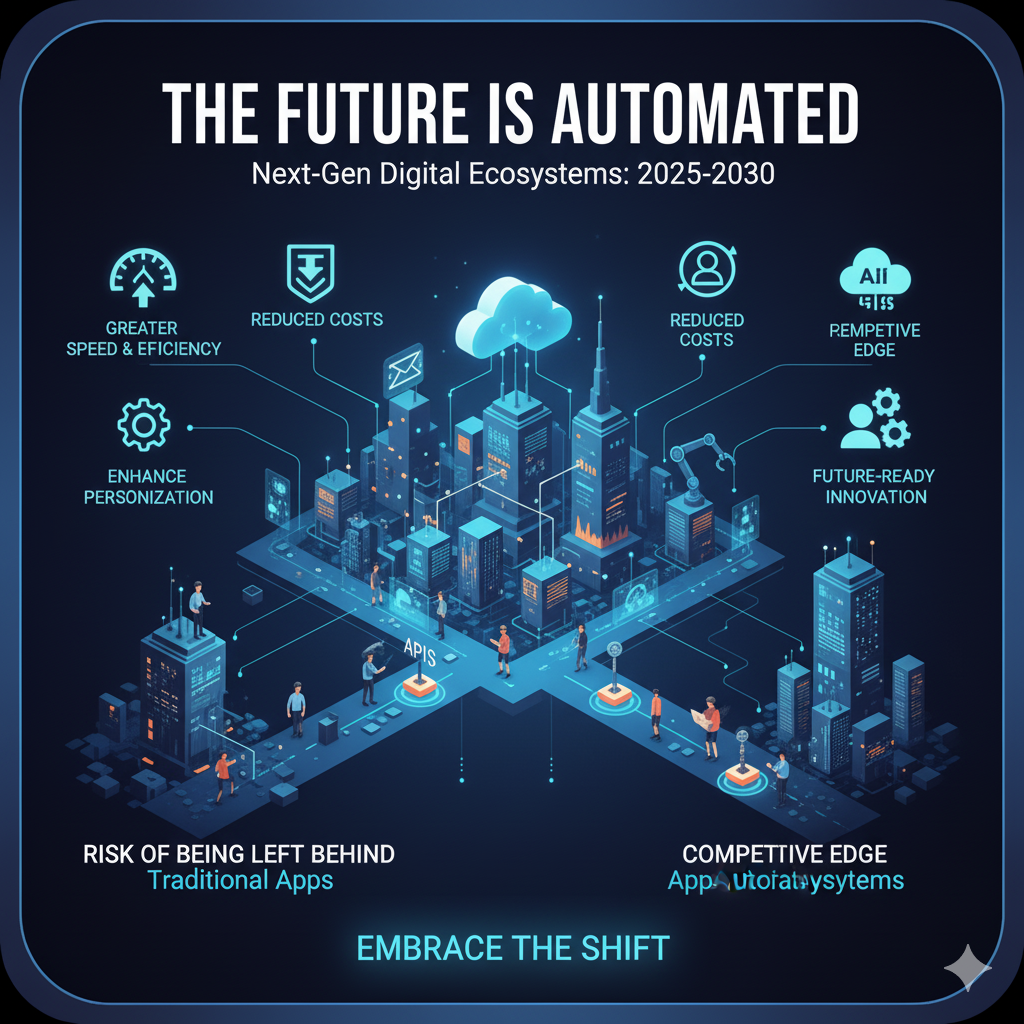The future of technology is not about individual apps working in isolation but about creating a connected environment where applications interact, automate, and evolve together. This is where the App Automation Ecosystem comes in.

Defining App Automation Ecosystem in Simple Terms
An App Automation Ecosystem can be understood as a network of applications, tools, and digital services that work together automatically without requiring constant human effort. Instead of a single app handling one function, an automation ecosystem integrates multiple apps so they share data, perform tasks, and execute workflows seamlessly. Think of it as a digital chain reaction where one app triggers another, creating a smooth and intelligent flow of actions.
Why Automation is the Backbone of Next-Gen Applications
Modern applications are no longer judged only by design or speed. They are valued for their ability to automate repetitive tasks, save time, and deliver instant results. The App Automation Ecosystem provides this backbone by:
- Reducing manual effort and eliminating repetitive tasks.
- Allowing applications to integrate through APIs and automation tools.
- Enabling real-time decision making with AI and machine learning.
- Creating intelligent workflows that adapt to user behavior.
In short, automation transforms applications into smart systems that think, respond, and act almost like human assistants.
Importance for Businesses, Developers, and End-Users
The App Automation Ecosystem is not just a technical trend, it is a complete shift in how digital solutions are built and consumed. Its impact can be seen across every level of technology adoption:
- For Businesses
- Improves productivity by automating internal operations.
- Cuts costs by reducing the need for manual labor.
- Enhances customer experience with faster, smarter services.
- For Developers
- Simplifies complex coding tasks by using automation frameworks.
- Opens opportunities for low-code and no-code development.
- Provides flexibility to build scalable and intelligent applications.
- For End-Users
- Offers seamless experiences across multiple apps and platforms.
- Provides instant responses through automated workflows.
- Creates personalization by adapting to user behavior.
The App Automation Ecosystem is setting the stage for the next decade of digital transformation. By 2030, automation will no longer be an added feature but a standard expectation in every successful application.
What is an App Automation Ecosystem
Explanation of Interconnected Automated Tools, APIs, and Workflows
An App Automation Ecosystem is a digital environment where different applications, tools, and platforms work together through automation. Instead of operating in isolation, these apps communicate through APIs, share data in real time, and perform actions automatically. This ecosystem connects multiple workflows so that when one action is triggered, the next process begins without manual input.

In a true App Automation Ecosystem, the following elements interact seamlessly:
- Automated Tools that handle repetitive tasks like scheduling, data entry, or notifications.
- APIs that allow applications to exchange information and perform combined functions.
- Workflows that connect different apps into a chain of automated actions, creating efficiency and reducing human effort.
This interconnected structure makes applications smarter, faster, and more reliable compared to standalone apps.
Difference Between Traditional Apps and Automated Ecosystems
Traditional applications usually focus on a single function or a limited set of tasks. They require manual input to operate, and users often have to switch between different apps to complete a process. For example, a business might use one app for emails, another for task management, and another for customer support. Managing these apps separately leads to wasted time and fragmented data.
On the other hand, an App Automation Ecosystem eliminates these barriers. Instead of working independently, all apps are connected. For example, when a customer submits a support request, the system can automatically update the CRM, notify the support team, and send an acknowledgment email to the customer without any manual steps.
In simple terms:
- Traditional Apps → Work separately, limited automation, heavy manual effort.
- Automated Ecosystems → Work together, high automation, minimal manual effort.
Real-World Analogy
To better understand the App Automation Ecosystem, imagine a smart home. In a smart home, different devices such as lights, air conditioning, security systems, and appliances are all connected. When you unlock your door, the lights turn on, the thermostat adjusts, and your favorite playlist starts automatically. You do not have to control each device individually because the system works as one intelligent ecosystem.
In the same way, an App Automation Ecosystem integrates applications so they respond to each other. Just like smart homes or connected vehicles, these ecosystems create a smooth, personalized, and automated digital experience.
The App Automation Ecosystem is not just a technical upgrade but a complete transformation in how apps are built and experienced. It redefines efficiency, saves valuable time, and builds a future where applications operate as intelligent networks instead of isolated tools.
Why App Automation Matters in 2025–2030
The coming decade is set to redefine how digital applications are built, delivered, and experienced. As the technology landscape grows more complex, the App Automation Ecosystem becomes the foundation for faster innovation, smarter decision-making, and seamless user experiences. Between 2025 and 2030, the importance of automation will only increase, making it essential for businesses, developers, and users.

Growing Demand for Faster and Smarter Apps
Speed and intelligence are no longer luxuries, they are expectations. Users want applications that can respond instantly, adapt to their behavior, and deliver value without delays. The App Automation Ecosystem addresses this demand by integrating AI, APIs, and workflows that remove unnecessary steps.
- Applications run faster by automating repetitive processes.
- Smart decision-making reduces manual input and improves accuracy.
- Users gain real-time responses across platforms and devices.
As markets become more competitive, automation is the only way to keep pace with growing demands for speed and intelligence.
Reduced Development Time with Low-Code and No-Code Platforms
One of the major benefits of the App Automation Ecosystem is its ability to simplify the development process. Low-code and no-code tools are changing the way apps are created, allowing both developers and non-developers to build automation without advanced programming skills.
- Reduces time to market by cutting down manual coding.
- Empowers businesses to innovate without waiting for large technical teams.
- Provides agility for startups and enterprises to experiment quickly.
- Ensures faster adoption of digital solutions across industries.
This shift means that automation will not be restricted to experts but will be accessible to anyone with a vision to build smarter apps.
Cost Efficiency for Startups and Enterprises
The financial benefits of the App Automation Ecosystem are just as important as its technical advantages. By reducing manual work, streamlining workflows, and minimizing errors, automation lowers operational costs for organizations of all sizes.
- Eliminates the need for repetitive human labor.
- Reduces infrastructure expenses through cloud and edge integration.
- Enhances resource allocation by automating background processes.
- Helps startups scale efficiently without heavy upfront investment.
In a competitive economy, cost efficiency becomes a strategic advantage, and automation provides exactly that.
Enhanced User Experience through Hyper-Personalization
The modern user expects applications to understand their needs. Hyper-personalization is possible only when apps can gather data, learn from it, and adjust experiences in real time. The App Automation Ecosystem achieves this by combining AI, machine learning, and workflow automation.
- Adapts app experiences based on individual behavior.
- Provides custom recommendations and instant support.
- Ensures consistency across devices and platforms.
- Builds long-term loyalty by making the user feel understood.
By 2030, personalization will no longer be optional. It will be a key factor in user retention, and automation will be the driving force behind it.
Final Thoughts
The App Automation Ecosystem matters because it aligns with the future of technology. It reduces complexity, cuts costs, accelerates development, and elevates user satisfaction. From startups s
eeking growth to enterprises managing scale, automation will be the defining feature of successful ap
Use Cases of App Automation Ecosystem
The value of the App Automation Ecosystem becomes most visible when applied to real-world scenarios. Across industries, automation is no longer just a convenience but a necessity to meet growing demands for speed, accuracy, and personalization. Below are the key use cases that show how automation is transforming the way applications are used between 2025 and 2030.
Business Applications: CRM, HR, and Finance Automation
Businesses thrive on efficiency, and the App Automation Ecosystem helps achieve it by automating core functions. Instead of employees spending hours on repetitive tasks, automated workflows ensure accuracy and speed.
- Customer Relationship Management (CRM): Automates lead tracking, customer follow-ups, and reporting.
- Human Resources (HR): Simplifies recruitment, onboarding, attendance, and performance tracking.
- Finance: Streamlines invoicing, expense tracking, and compliance checks.
By connecting these processes, businesses reduce manual effort and create a seamless flow of information across departments, leading to improved productivity and decision-making.
Healthcare: Automated Patient Tracking and AI Diagnostics
Healthcare is one of the industries that benefits the most from the App Automation Ecosystem. Automation ensures faster services, accurate results, and better patient care.
- Patient Tracking: Wearable devices and hospital apps automatically sync patient data for real-time monitoring.
- AI Diagnostics: Machine learning helps detect patterns in medical data for quicker and more reliable diagnosis.
- Appointment Management: Automated systems schedule and remind patients without human intervention.
This ecosystem reduces errors, saves time for healthcare professionals, and enhances the quality of patient care.
E-Commerce: Automated Customer Support and AI Chatbots
The e-commerce sector thrives on speed, personalization, and customer satisfaction. An App Automation Ecosystem ensures that businesses deliver at scale without losing quality.
- AI Chatbots: Provide instant customer support across websites and apps.
- Order Processing: Automatically updates inventory, sends invoices, and tracks deliveries.
- Personalized Recommendations: Uses automation to suggest products based on browsing history and preferences.
These features improve customer experience while reducing operational costs, making automation a core driver of e-commerce success.
Smart Cities and IoT: Automation for Public Services
The concept of smart cities relies heavily on the App Automation Ecosystem. By connecting IoT devices with automated applications, governments and organizations can manage cities more efficiently.
- Traffic Management: Automated systems monitor and control traffic signals to reduce congestion.
- Energy Efficiency: Smart grids optimize electricity usage by balancing supply and demand.
- Public Safety: Automated alert systems respond quickly to emergencies using connected sensors.
This ecosystem helps build sustainable, efficient, and intelligent urban environments that improve the lives of citizens.
Education: Personalized Learning and Virtual Assistants
Education is evolving rapidly, and the App Automation Ecosystem makes learning smarter, faster, and more engaging. By integrating AI and workflow automation, education becomes highly personalized.
- Personalized Learning Paths: Adapts content and pace according to the student’s progress.
- Virtual Assistants: Provide instant support to students for queries and assignments.
- Administrative Automation: Automates tasks like attendance, grading, and scheduling.
This leads to more interactive learning experiences and reduces the burden on teachers and institutions.
Final Thoughts on Use Cases
The App Automation Ecosystem is not limited to a single industry. From business operations to healthcare, e-commerce, urban development, and education, automation is shaping the future of every sector
. By 2030, industries that embrace these ecosystems will not o
Challenges and Risks of App Automation Ecosystem
While the App Automation Ecosystem offers speed, intelligence, and efficiency, it is not free from challenges. Every innovation carries potential risks, and automation is no exception. To build sustainable and future-ready systems, businesses and developers must carefully address these hurdles.
Data Security and Privacy Issues
One of the biggest challenges of the App Automation Ecosystem is ensuring data security. Since automation requires apps to exchange information continuously, sensitive data is often stored and transmitted across multiple platforms. Without strict security measures, this creates opportunities for breaches and misuse.
- Risks of unauthorized access and cyberattacks.
- Increased vulnerability when third-party apps are connected.
- Legal and compliance issues related to data handling.
- Difficulty in ensuring user trust if privacy is compromised.
Securing automated workflows with encryption, authentication, and compliance standards is essential for building confidence in automation ecosystems.
Over-Dependency on Automation
Automation is powerful, but relying too heavily on it can create long-term risks. If every process is automated, businesses may lose flexibility and adaptability when unexpected situations occur.
- Human oversight becomes limited in critical decisions.
- Errors in automated systems may go unnoticed for long periods.
- Organizations may lose essential manual skills.
- System failures can disrupt entire workflows at once.
A balanced approach, where automation supports human judgment instead of replacing it, is crucial for stability.
Integration Complexity Across Platforms
An App Automation Ecosystem connects multiple tools, APIs, and workflows. While this integration creates efficiency, it also brings complexity. Different platforms may not always communicate smoothly, leading to issues in performance and reliability.
- Compatibility issues between old and new systems.
- Increased maintenance costs for keeping apps connected.
- Technical challenges when scaling automation across regions.
- Risk of delays or failures if one app in the ecosystem breaks down.
Careful planning, standardization, and strong API management are necessary to reduce integration challenges.
Skill Gap for Developers in AI Automation
As the App Automation Ecosystem expands, the demand for skilled developers in AI and automation grows. However, the industry faces a significant skill gap. Not every developer is trained in advanced automation tools, AI integration, or workflow design.
- Shortage of professionals with expertise in AI-driven automation.
- Difficulty for businesses to find and retain skilled developers.
- Learning curve for adopting new low-code and no-code tools.
- Slower adoption of automation due to lack of technical knowledge.
Bridging this gap through training, education, and collaboration will be key for the success of future automation ecosystems.
Final Thoughts on Challenges and Risks
The App Automation Ecosystem has immense potential, but its success depends on how businesses manage these risks. Data security, balanced automation, smooth integration, and skilled talent are the foundations for building reliable ecosystems. Addressing these challenges will ensure that automation continues to drive innovation without creating long-term problems.
Future of App Automation Ecosystem 2030 Vision
The App Automation Ecosystem is not just shaping today’s applications but also defining the digital future. By 2030, automation will no longer be an additional feature. It will be the foundation on which modern applications are built. From intelligent decision-making to self-healing capabilities, the ecosystem will evolve into a fully integrated digital environment that runs smarter, faster, and more securely than ever before.
Rise of Self-Healing Applications
By 2030, apps will go beyond automation to become self-healing systems. These applications will detect problems on their own and fix them without human intervention. For example, if a workflow breaks or an integration fails, the system will instantly identify the issue and apply the solution.
- Reduced downtime due to automated problem resolution.
- Stronger reliability in mission-critical applications.
- Continuous optimization for performance without manual effort.
- A proactive approach where apps anticipate problems before they occur.
This advancement will transform how businesses and end-users experience software, making automation ecosystems more resilient and future-proof.
Quantum Computing Impact on Automation
The App Automation Ecosystem will also be revolutionized by quantum computing. While still emerging, quantum technology promises to deliver computing power far beyond traditional systems.
- Faster processing of complex automation tasks.
- Real-time analysis of massive datasets.
- Improved security with quantum-safe encryption methods.
- Unmatched potential in industries like finance, healthcare, and logistics.
By combining automation with quantum computing, businesses will achieve insights and decision-making speeds that were previously impossible.
Fully Integrated AI-Driven App Ecosystems
In the 2030 vision, AI will not just be a component but the core of automation ecosystems. Every app will connect to an intelligent network where data flows seamlessly, decisions are made instantly, and experiences are deeply personalized.
- Applications will communicate with each other without friction.
- Predictive AI will guide business processes in real time.
- End-users will experience adaptive apps that learn and evolve with usage.
- Automation will extend across industries, from smart healthcare to autonomous urban systems.
This integration will build a future where applications act as intelligent partners instead of just tools.
Automation as the Default App Standard
By 2030, automation will no longer be considered optional. The App Automation Ecosystem will become the default standard for all apps, whether designed for businesses, developers, or consumers.
- Every app will have built-in automation capabilities.
- Low-code and no-code platforms will make automation accessible to all.
- Businesses will save time and costs as automation becomes the norm.
- End-users will expect automation as part of their daily digital interactions.
This shift means that businesses that fail to adopt automation will risk falling behind, while those embracing it will lead innovation in their industries.
Closing Thoughts on the 2030 Vision
The Future of App Automation Ecosystem points to a world where self-healing systems, quantum-powered intelligence, and AI-driven integration redefine how apps function. Automation will not just support applications, it will define them. By 2030, businesses, developers, and users will enter a new digital era where automation is the heart of every application ecosystem.nly achieve efficiency but also gain a competitive advantage through innovation and customer satisfaction.plications between 2025 and 2030.
Conclusion
The App Automation Ecosystem is no longer a futuristic idea. It is becoming the backbone of next-generation digital solutions. From intelligent workflows and AI-driven decisions to seamless integrations and self-healing systems, automation is transforming how businesses, developers, and end-users experience applications.

Recapping its importance, the ecosystem offers:
- Greater speed and efficiency in application development.
- Reduced costs and smarter resource utilization.
- Enhanced personalization for users across industries.
- Future-ready innovation through AI, cloud, and IoT integration.
The opportunities are immense. By adopting the App Automation Ecosystem, businesses can unlock scalability, developers can build intelligent systems faster, and users can benefit from applications that adapt to their needs in real time.
Looking ahead to 2025–2030, automation will no longer be an added feature but the default foundation of all apps. Organizations that invest in this ecosystem today will gain a long-term competitive edge, while those who resist change may risk being left behind in a rapidly evolving digital market.
Businesses and developers must prepare for the shift from apps to ecosystems. The winners of tomorrow will be those who embrace automation as a core strategy, not as an afterthought.